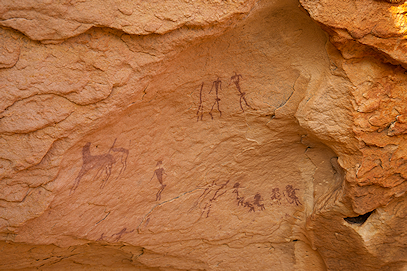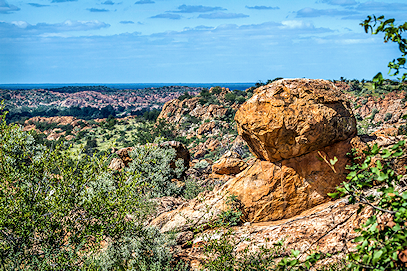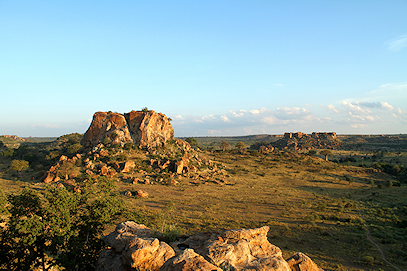South Africa's Mapungubwe National Park
Help Me Plan- Home
- >
- African Travel
- >
- South Africa
- >
- National Parks
- >
- Mapungubwe National Park
Mapungubwe National Park Destination Guide
Mapungubwe rises on a steep, rocky hill accessible only through a single narrow cleft. Once a natural fortress and the heart of a sophisticated kingdom, it preserves artifacts like the famed Golden Rhino. Today the park blends archaeology, baobab-studded savanna, and Limpopo River vistas, offering evocative heritage tours alongside quiet wildlife viewing.
Getting There
By Air: Mapungubwe is situated in the far northern reaches of South Africa, on the border of Botswana. Guests traveling to the park are welcomed at OR Tambo International Airport in Johannesburg, assisted with a transfer to Polokwane, and then chartered to Mapungubwe’s private airstrip or transferred by air-conditioned vehicle.
By Road: Guests are transported via a private, air-conditioned 4x4 vehicle from either Polokwane or a previous destination on your itinerary. The park is approximately 200 km from Polokwane and offers scenic views of the South African landscape. Driving options are also available from Botswana’s side.
Weather & Best Time To Visit
Mapungubwe is rewarding for most of the year. Summer (November to February) can be very hot. This is the rainy season, but rainfall is sparse (about 10 rainy days per year) and offers little relief, with temperatures sometimes rising to 45 °C.
The dry season is best for game viewing and coincides with the cooler winter months (May to September). During the dry season, animals concentrate at water sources. Birders often prefer spring or early summer to balance migrants with manageable heat.

At Mapungubwe National Park, visitors can join guided trips to cultural and archaeological sites, visit the Tree Top Walk and bird hides, and explore self-guided trails. Bird-watching outings and night game drives are offered. You can visit the graveyard atop Mapungubwe Hill, see a natural amphitheater, and walk the territory once trod by Mapungubwe ancestors where wildlife now reigns.
Reasons to visit Mapungubwe National Park
Treetop Walks
The treetop walkway overlooking the Limpopo River near Leokwe Camp offers magnificent vistas over the river and landscape. Placards identify trees along the route, and the walkway ends at the Maloutswa bird hide.
All Hands on Deck
Viewing decks at the river confluence—four decks including a popular sunset deck—offer insight into the park’s terrain and significance. From here you can see where South Africa, Botswana, and Zimbabwe meet at the confluence of the Shashe and Limpopo rivers, and watch wildlife frequenting the water.
The Hill of Inquiry
Walking up Mapungubwe Hill to discover the ancient African kingdom is a profound historical experience. It is eerily enchanting to wander among the remains of a powerful society estimated to have lived here between 1200 and 1290, leaving behind gold and precious artifacts. The lingering question is why they left.
Experiences to Savor at Mapungubwe National Park
Mapungubwe National Park may host abundant wildlife, but its fascinating historical sites and unique geology set it apart. Savor the privilege of an unorthodox glimpse into the past.

Relive the Past
Mapungubwe offers the rare chance to visit places and view artifacts crafted hundreds to thousands of years ago. The insight into past lifestyles and capabilities inspires renewed respect for earlier civilizations.
Striking Sandstone
The sandstone rock features at Mapungubwe are remarkable in size and shape. Stone masonry illustrates how vital this geology was to former inhabitants, and the formations continue to amaze.
Burial Grounds at Mapungubwe Hill
The burial site at Mapungubwe reveals a rich culture that traded with India and China. Like the pharaohs of Egypt, royalty were interred with valuable artifacts.Useful Information
History
Mapungubwe National Park was proclaimed on Heritage Day, 24 September 2004, after the area was established as Vhembe Dongola National Park on 9 April 1998.
Mapungubwe is important for paleontological and anthropological treasures buried in the landscape. Two early plant-eating dinosaurs—Plateosauravus, which grew about 10 m and lived 210 million years ago, and Massospondylus, about 6 m and 195 million years old—have been excavated here. The most famous discovery involves the Leopard Kopje people, renowned as one of Africa’s earliest indigenous kingdoms that lived here between 1220 and 1300 AD. Royal graves were found in the 1930s with golden artifacts, including the Golden Rhino. Mapungubwe also preserves sites of human activity dating back as far as 300,000 years.
Wildlife
Mapungubwe National Park has four of the Big Five, excluding buffalo. Elephant are the only common Big Five specie. Leopard and rhino are occasionally spotted, and lion only very rarely. The chances of spotting giraffe are good, and you’ll sometimes encounter hippo. Predators including wild dog, cheetah, hyena, and caracal occur here, though sightings are infrequent. Several antelope species occur, from klipspringer to eland. The shy aardvark is relatively common.
The park is home to 17 bat species, including Wahlberg’s epauletted and Egyptian fruit bat. Other lesser mammals range from warthog and honey badger to civet and porcupine. Reptiles are plentiful; you might see anything from Nile crocodile to rock monitor lizard. Be wary of highly venomous snakes such as black mamba and puff adder, and keep an eye out for the large Southern African rock python. Bird watchers will delight, as 387 bird species have been recorded in the park and over 400 in the surrounding area. Verreaux’s eagle occurs in high density; cuckoo are abundant, and even Pel’s fishing owl may be seen if you are lucky.
Vegetation & Terrain
Mapungubwe lies in Limpopo Province on the southern floodplains of the Limpopo River, the natural border between South Africa and Botswana. From the park you can see the meeting place of the Limpopo and Shashe rivers, where the borders of Zimbabwe, Botswana, and South Africa converge.
The area hosts varied habitats that support diverse plant species such as acacia, fig, fever, and Commiphora trees. Water-rich floodplain soils grow enormous trees, including huge baobabs—one specimen boasts a circumference of 31 m. The area also holds great cultural significance and is a proclaimed World Heritage Site. The remains of the ancient civilization atop Mapungubwe Hill are focal to conservation efforts. The famous Golden Rhino was found here and can be viewed in the park museum.
Activities
Do not miss the museum, where you can view the celebrated Golden Rhino and learn about the cultural heritage that makes this park unique. It also offers deeper context about the landscape and its wildlife. The heritage tour lets visitors step back in time while encountering the animals that now rule the region.
Game drives are available, and night drives are popular for searching out nocturnal wildlife. Guided bush walks provide a slower, immersive experience. The Tree Top Walk offers a different perspective on the landscape and concludes at a hide overlooking the majestic Limpopo River.









